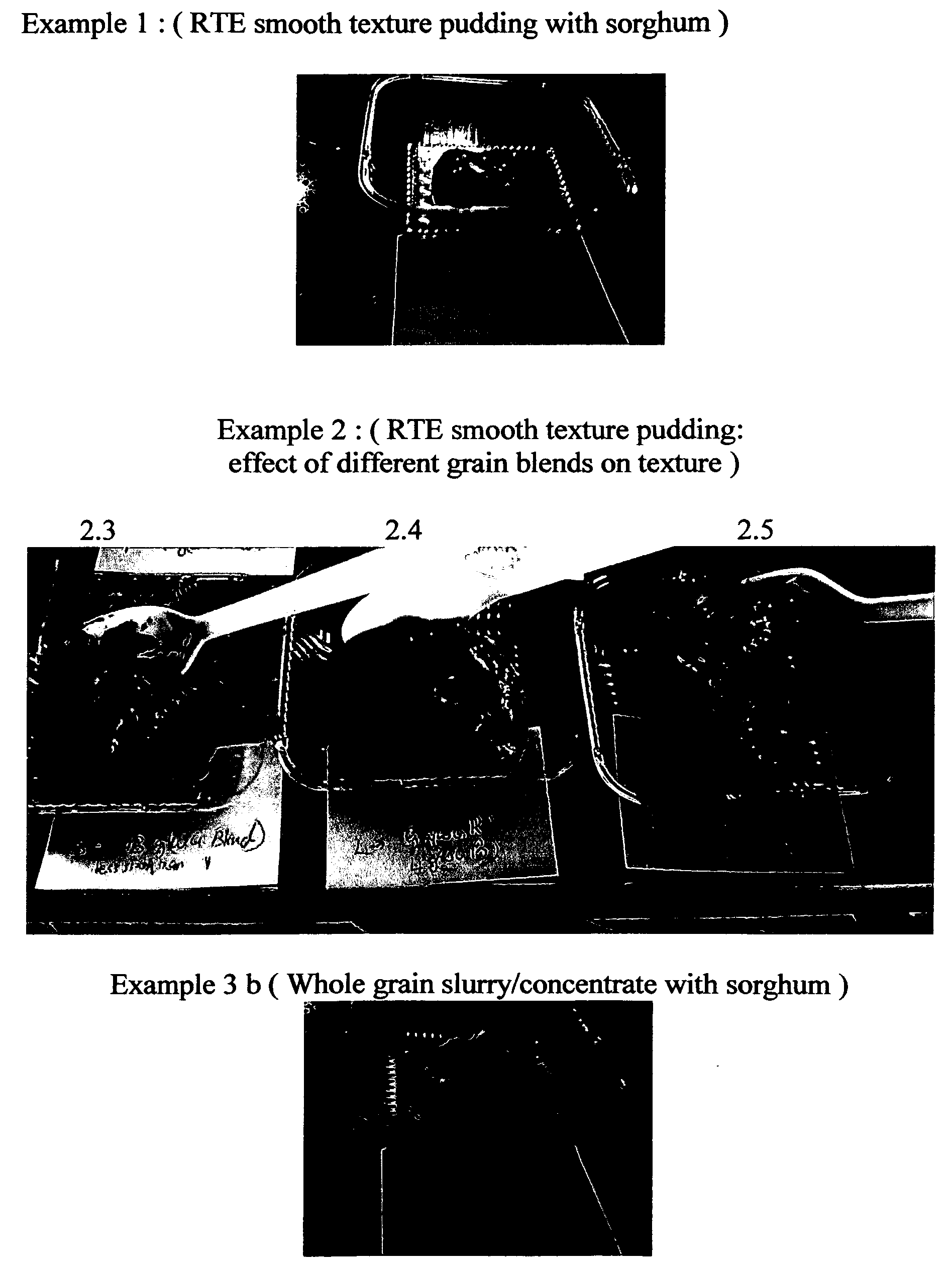Whole grains in consumable products
a consumable product and whole grain technology, applied in the field of whole grain in consumable products, can solve the problems of difficult to add whole grains into semi-solid food products, difficult to maintain the optimal sensory characteristics of products, etc., and achieve the effect of reducing the microbial load of whole grain flour and low microbial counts
- Summary
- Abstract
- Description
- Claims
- Application Information
AI Technical Summary
Benefits of technology
Problems solved by technology
Method used
Image
Examples
examples
Ready to Eat Pudding
[0025]The sensory properties of the pudding are impacted by type and nature of the whole grains and fiber and additional. functional components added.
[0026]In example 1, the following ingredients are mixed and processed stove top at 180 F for 5 mins and cooled to 40 F.
Sugar14-16gStarch2-3gCocoa powder2-3gSorghum (whole grain)4-6gSalt, flavors0.2-0.5gFiber (soluble corn)3-5gMilk (2%)72-75g
[0027]The finished product has a nice smooth consistency, has a good flavor with no bitter notes and may be labeled as natural and gluten free. Starch (Novation 3300) from National Starch, NJ and whole grain sorghum flour from ConAgra Mills, Omaha, Nebr. is used. On a sensory scale of 1-5 where 5 is considered very good, the finished product has a overall sensory acceptance of 3.5. Photo of sample is attached.
example 2
[0028]In this example, effect of different whole grains on flavor and texture were evaluated. The following base formula was used.
Sugar26gStarch4gCocoa5gSalt / flavors / natural sweetness enhancers0.815-1.31gWhole grains13g2% milk150-151g (adjust to 200 g)[0029]2:3—Whole grain blend 13 g (quinoa, amaranth, sorghum, teff and millet) was used.[0030]2:4—Toasted finely milled whole grain rice 9 g and 4 g whole grain blend (quinoa, amaranth, sorghum, teff and millet) was used.[0031]2:5—Toasted whole grain oats 9 g and 4 g whole grain blend (quinoa, amaranth, sorghum, teff and millet) was used.
Sensory Characteristics:
[0032]2:3 was too thick and pasty and had a bitter note, sample 2:4 had rice notes but was of smoother consistency and sample 2:5 was similar to sample 2:3 in consistency. Oats and whole grain blend seem to absorb more water and result in a pasty texture while sample 2.4 with rice and less amount of whole grain blend had a smoother consistency.
[0033]In comparison to rice and oats...
example 3
[0035]Whole grain slurry or concentrate was prepared with sorghum with and without whole grain blend.[0036]3.a. Whole grain slurry / concentrate (sorghum with whole grain blend) Sorghum and whole grain blend (7.5 g each) was combined with 7 g sugar and 66 g 2% milk. The above blend was mixed and heated at 175 F for 3-5 mins until thickened. Final yield was 85% resulting in 20% whole grain in final slurry or concentrate.
[0037]The slurry or concentrate was substituted for whole grain flour as follows:
A (with WG flour)B (with WG slurry / concentrate)Sugar29.5g29.5 g Starch4g4 gCocoa5g5 gSalt / flavors0.63g0.63 g Fiber3g3 gWG (sor / blend)8g (4:4)—WG slurry38 g 2% milk150g118 g
[0038]Slurry was mixed with the milk in B and dry ingredients blended. Both products were heated at 180 F for 5 minutes and cooled. Slurry or concentrate sample may be slightly thinner in consistency and may be slightly lumpy. The slurry or concentrate may need to be homogenized for smoother consistency. pH of the slur...
PUM
 Login to View More
Login to View More Abstract
Description
Claims
Application Information
 Login to View More
Login to View More - R&D
- Intellectual Property
- Life Sciences
- Materials
- Tech Scout
- Unparalleled Data Quality
- Higher Quality Content
- 60% Fewer Hallucinations
Browse by: Latest US Patents, China's latest patents, Technical Efficacy Thesaurus, Application Domain, Technology Topic, Popular Technical Reports.
© 2025 PatSnap. All rights reserved.Legal|Privacy policy|Modern Slavery Act Transparency Statement|Sitemap|About US| Contact US: help@patsnap.com

